Blockchain Enhanced Emission Trading Framework in Fashion Apparel Manufacturing Industry
Abstract
:1. Introduction
2. Blockchain and Current Applications to Improve Sustainability
2.1. Blockchain Technology
2.2. Blockchain Applications to Improve Sustainability, an Example in the Clean Energy Industry
3. Improvement of Environmental Sustainability in Fashion Apparel Manufacturing Industry
3.1. Blockchain Supported Emission Trading Scheme
3.2. Carbon Emission from Fashion Apparel Manufacturing Chain
3.3. Emission Link
4. Case Study and Uncertainties
4.1. Case Study
4.2. Determination of the Uncertainties
5. Multi-Criteria Evaluation
5.1. Assessment of Environmental Performance
5.2. Assessment of Political Acceptability
5.3. Assessment of Feasibility of Implementation
5.4. Summary of Evaluation
6. Discussions
7. Conclusions
Acknowledgments
Author Contributions
Conflicts of Interest
References
- Lasi, H.; Kemper, H.G.; Fettke, P.; Feld, T.; Hoffmann, M. Industry 4.0. Bus. Inf. Syst. Eng. 2014, 6, 239–242. [Google Scholar] [CrossRef]
- Liao, Y.; Deschamps, F.; Loures, E.F.R.; Ramos, L.F.P. Past, present and future of Industry 4.0-a systematic literature review and research agenda proposal. Int. J. Prod. Res. 2017, 55, 3609–3629. [Google Scholar] [CrossRef]
- Roblek, V.; Meško, M.; Krapež, A. A complex view of industry 4.0. SAGE Open 2016, 6, 1–11. [Google Scholar] [CrossRef]
- Long, F.; Zeiler, P.; Bertsche, B. Modelling the production systems in industry 4.0 and their availability with high-level petri nets. In IFAC-PapersOnLine, Proceedings of the 8th IFAC Conference on Manufacturing Modelling, Management and Control (MIM), Troyes, France, 28–30 June 2016; Elsevier Science B.V.: Amsterdam, The Netherlands, 2016. [Google Scholar]
- Gruber, F.E. Industry 4.0: A best practice project of the automotive industry. In Digital Product and Process Development Systems, Proceedings of the IFIP TC 5 International Conference on Project Research on Leading-Edge Applications and Methods for Applied Information Technology, Dresden, Germany, 10–11 October 2013; Springer: Berlin, Germany, 2013. [Google Scholar]
- Wan, J.; Tang, S.; Shu, Z.; Li, D.; Wang, S.; Imran, M.; Vasilakos, A. Software-defined industrial internet of things in the context of Industry 4.0. IEEE Sens. J. 2016, 16, 7373–7380. [Google Scholar] [CrossRef]
- Lu, Y. Industry 4.0: A survey on technologies, applications and open research issues. J. Ind. Inf. Integr. 2017, 6, 1–10. [Google Scholar] [CrossRef]
- Sikorski, J.J.; Haughton, J.; Kraft, M. Blockchain technology in the chemical industry: Machine-to-machine electricity market. Appl. Energy 2017, 195, 234–246. [Google Scholar] [CrossRef]
- Khaqqi, K.N.; Sikorski, J.J.; Hadinoto, K.; Kraft, M. Incorporating seller/buyer reputation-based system in blockchain-enabled emission trading application. Appl. Energy 2018, 209, 8–19. [Google Scholar] [CrossRef]
- Global Coin Report. Understanding the Core Concepts Behind QTUM. Available online: https://globalcoinreport.com/understanding-core-concepts-behind-qtum (accessed on 11 February 2018).
- Energy Blockchain Labs. Available online: http://www.energy-blockchain.com/EnHome (accessed on 11 February 2018).
- EP-Chain. Available online: http://www.ep-chain.org (accessed on 6 February 2018). (In Chinese).
- Martin, M. Creating Sustainable Apparel Value Chains. Impact Economy. 2013, pp. 1–41. Available online: https://aicprogram.com/reports/IE_PRIMER_DECEMBER2013_EN.pdf (accessed on 5 March 2018).
- Chen, H.-L.; Burns, L.D. Environmental analysis of textile products. Cloth. Text. Res. J. 2006, 24, 248–261. [Google Scholar] [CrossRef]
- Zaffalon, V. Climate change, carbon mitigation and textiles. Text. World 2010, 160, 34–35. [Google Scholar]
- Nakamoto, S. Bitcoin: A peer-to-peer electronic cash system. Available online: https://bitcoin.org/bitcoin.pdf (accessed on 31 January 2018).
- Swan, M. Blockchain: Blueprint for a New Economy; O’Reilly Media Inc.: Sebastopol, CA, USA, 2015; p. xi. ISBN 9781491920497. [Google Scholar]
- Bhargavan, K.; Delignat-Lavaud, A.; Fournet, C.; Gollamudi, A.; Gonthier, G.; Kobeissi, N.; Kulatova, N.; Rastogi, A.; Sibut-Pinote, T.; Swamy, N. Formal verification of smart contracts short paper. In Proceedings of the 2016 ACM Workshop on Programming Languages and Analysis for Security (PLAS’16), 11th ACM Workshop on Programming Languages and Analysis for Security (PLAS), Vienna, Austria, 24 October 2016; Association Computing Machinery: New York, NY, USA, 2016. [Google Scholar]
- Jakobsson, M.; Juels, A. Proofs of work and bread pudding protocols. In Secure Information Networks: Communications and Multimedia Security, Proceedings of the IFIP TC6/TC11 Joint Working Conference on Communication and Multimedia Security (CMS 99), Leuven, Belgium, 20–21 September 1999; Kluwer Academic Publishers: Norwell, MA, USA, 1999. [Google Scholar]
- Boneh, D.; Di Crescenzo, G.; Ostrovsky, R.; Persiano, G. Public key encryption with keyword search. In Advances in Cryptology—Eurocrypt 2004, Proceedings of the 23rd Annual Eurocrypt Conference, Interlaken, Switzerland, 2–6 May 2004; Springer: Berlin, Germany, 2004. [Google Scholar]
- Aitzhan, N.Z.; Svetinovic, D. Security and privacy in decentralized energy trading through multi-signatures, blockchain and anonymous messaging streams. IEEE Trans. Dependable Secur. Comput. 2016, 1–14. [Google Scholar] [CrossRef]
- Pop, C.; Cioara, T.; Antal, M.; Anghel, I.; Salomie, I.; Bertoncini, M. Blockchain based decentralized management of demand response programs in smart energy grids. Sensors 2018, 18. [Google Scholar] [CrossRef] [PubMed]
- Aune, R.T.; Krellenstein, A.; O’Hara, M.; Slama, O. Footprints on a blockchain: Trading and information leakage in distributed ledgers. J. Trading 2017, 12, 5–13. [Google Scholar] [CrossRef]
- Liu, W.; Wang, T.; Liu, Y.; Sun, C.; Zeng, M. Research on the technology and economic calculation model of power transmission line considering environmental benefits. In AIP Conference Proceedings, Proceedings of the International Conference on Materials Science, Resource and Environmental Engineering (MSREE), Xian, China, 10–11 December 2016; American Institute of Physics: Melville, NY, USA, 2017. [Google Scholar]
- Hwang, J.; Choi, M.I.; Lee, T.; Jeon, S.; Kim, S.; Park, S.; Park, S. Energy prosumer business model using blockchain system to ensure transparency and safety. In Power And Energy Systems Engineering (CPESE 2017), Proceedings of the 4th International Conference on Power and Energy Systems Engineering (CPESE), Berlin, Germany, 25–29 September 2017; Elsevier Science B.V.: Amsterdam, The Netherlands, 2017. [Google Scholar]
- Mylrea, M.; Gourisetti, S.N.G. Blockchain for smart grid resilience: Exchanging distributed energy at speed, scale and security. In Proceedings of the Resilience Week (RWS) 2017, Wilmington, DE, USA, 18–22 September 2017; IEEE-Inst Electrical Electronics Engineers Inc.: Piscataway, NJ, USA, 2017. [Google Scholar]
- Hou, J.; Wang, H.; Liu, P. Applying the blockchain technology to promote the development of distributed photovoltaic in China. Int. J. Energy Res. 2018, 1–12. [Google Scholar] [CrossRef]
- Exergy. Available online: https://lo3energy.com (accessed on 27 February 2018).
- Mengelkamp, E.; Garttner, J.; Rock, K.; Kessler, S.; Orsini, L.; Weinhardt, C. Designing microgrid energy markets a case study: The brooklyn microgrid. Appl. Energy 2018, 210, 870–880. [Google Scholar] [CrossRef]
- SolarCoin. Available online: https://solarcoin.org/en/front-page (accessed on 8 March 2018).
- Grid Singularity. Available online: http://gridsingularity.com (accessed on 1 March 2018).
- Grid+. Available online: https://gridplus.io (accessed on 1 March 2018).
- Zhou, Y.; Wu, J.; Long, C.; Cheng, M.; Zhang, C. Performance evaluation of peer-to-peer energy sharing models. Energy Procedia 2017, 143, 817–822. [Google Scholar] [CrossRef]
- PONTON—The Enerchain Project. Available online: https://enerchain.ponton.de (accessed on 2 March 2018).
- Share&Charge. Available online: https://shareandcharge.com (accessed on 17 March 2018).
- Wood, G. ETHEREUM: A Secure Decentralised Generalized Transaction Ledger. Available online: http://gavwood.com/paper.pdf (accessed on 18 July 2017).
- Oxygen Initiative. Available online: https://oxygeninitiative.com (accessed on 17 March 2018).
- Starting from the Micro Power Grid, Energo Tries to Build a Decentralized Autonomous Energy Transaction System Using Blockchain Technologies. Available online: http://www.8btc.com/energo-labs-blockchain (accessed on 25 January 2018). (In Chinese).
- Breidenich, C.; Magraw, D.; Rowley, A.; Rubin, J.W. Kyoto protocol to the United Nations framework convention on climate change. Am. J. Int. Law 1998, 92, 315–331. [Google Scholar] [CrossRef]
- Bond, P. Emissions trading, new enclosures and eco-social contestation. Antipode 2011, 44, 684–701. [Google Scholar] [CrossRef]
- Schneider, L.; Kollmuss, A.; Lazarus, M. Addressing the risk of double counting emission reductions under the UNFCCC. Climatic Change 2015, 131, 473–486. [Google Scholar] [CrossRef]
- Segura, S.; Ferruz, L.; Gargallo, P.; Salvador, M. Environmental versus economic performance in the EU ETS from the point of view of policy makers: A statistical analysis based on copulas. J. Clean. Prod. 2018, 176, 1111–1132. [Google Scholar] [CrossRef]
- Ellerman, A.D.; Buchner, B.K. The European Union Emissions Trading Scheme: Origins, allocation, and early results. Rev. Environ. Econ. Policy 2007, 1, 66–87. [Google Scholar] [CrossRef]
- CleanMetrics. Carbon Footprint Analysis for Clothing and Accessories. Available online: http://www.cleanmetrics.com/html/clothing_carbon_footprints.htm (accessed on 5 April 2017).
- World Wildlife Fund. Cutting Cotton Carbon Emissions: Findings from Warangal, India. WWF Report. 2013. Available online: http://www.indiaenvironmentportal.org.in/files/file/cotton_carbon_emission.pdf (accessed on 5 March 2018).
- Giacomin, A.M.; Garcia, J.B.; Zonatti, W.F.; Silva-Santos, M.C.; Laktim, M.C.; Baruque-Ramos, J. Silk industry and carbon footprint mitigation. In IOP Conference Series-Materials Science and Engineering, Proceedings of the 17th World Textile Conference of the Association-of-Universities-for-Textiles (AUTEX)—Shaping the Future of Textiles, Corfu, Greece, 29–31 May 2017; IOP Publishing Ltd.: Bristol, UK, 2017. [Google Scholar]
- Perry, P. Exploring the influence of national cultural context on CSR implementation. J. Fash. Mark. Manag. 2012, 16, 141–160. [Google Scholar] [CrossRef]
- de Brito, M.P.; Carbone, V.; Blanquart, C.M. Towards a sustainable fashion retail supply chain in Europe: Organisation and performance. Int. J. Prod. Econ. 2008, 114, 534–553. [Google Scholar] [CrossRef]
- Weber, C.L.; Matthews, H.S. Quantifying the global and distributional aspects of American household carbon footprint. Ecol. Econ. 2008, 66, 379–391. [Google Scholar] [CrossRef]
- Bocken, N.M.P.; Allwood, J.M. Strategies to reduce the carbon footprint of consumer goods by influencing stakeholders. J. Clean. Prod. 2012, 35, 118–129. [Google Scholar] [CrossRef]
- Choi, T.-M. Local sourcing and fashion quick response system: The impacts of carbon footprint tax. Transp. Res. Part E Logist. Transp. Rev. 2013, 55, 43–54. [Google Scholar] [CrossRef]
- Waste and Resources Action Programme (WRAP) 2012 Final Report—A Carbon Footprint for UK Clothing and Opportunities for Savings. Available online: http://www.wrapni.org.uk/sites/files/wrap/Appendix%20IV%20-%20Carbon%20footprint%20report.pdf (accessed on 5 February 2018).
- Congressional Budget Office (CBO). Policy Options for Reducing CO2 Emissions: A CBO Study. Available online: http://www.cbo.gov/sites/default/files/02-12-carbon.pdf (accessed on 10 February 2018).
- Chen, X.; Benjaafar, S.; Elomri, A. The carbon-constrained EOQ. Oper. Res. Lett. 2012, 41, 172–179. [Google Scholar] [CrossRef]
- Song, J.; Leng, M. Analysis of the single-period problem under carbon emissions policies. In Handbook of Newsvendor Problems; Choi, T.-M., Ed.; Springer: New York, NY, USA, 2012; Volume 176, pp. 297–313. ISBN 9781461435990. [Google Scholar]
- He, L.; Zhao, D.; Xia, L. Game theoretic analysis of carbon emission abatement in fashion supply chains considering vertical incentives and channel structures. Sustainability 2015, 7, 4280–4309. [Google Scholar] [CrossRef]
- Adidas Sustainability Reports. Available online: https://www.adidas-group.com/en/sustainability/reporting/sustainability-reports (accessed on 10 March 2018).
- H&M Sustainability Report. Available online: http://sustainability.hm.com (accessed on 10 March 2018).
- Marks and Spencer’s Plan A. Available online: https://corporate.marksandspencer.com/plan-a (accessed on 11 February 2018).
- Nike Sustainable Nusiness Report. Available online: https://about.nike.com/pages/sustainable-innovation (accessed on 10 March 2018).
- Lin, Y.-P.; Petway, J.R.; Anthony, J.; Mukhtar, H.; Liao, S.-W.; Chou, C.-F.; Ho, Y.-F. Blockchain: The evolutionary next step for ICT e-agriculture. Environments 2017, 4. [Google Scholar] [CrossRef]
- Partnership for Market Readiness (PMR); International Carbon Action Partnership (ICAP). Emission Trading in Practice: A Handbook on Design and Implementation; World Bank: Washington, DC, USA, 2016. [Google Scholar]
- Choudhury, A.K.R. Environmental impacts of the textile industry and its assessment through life cycle assessment. In Roadmap to Sustainable Textiles and Clothing: Environmental and Social Aspects of Textiles and Clothing Supply Chain; Muthu, S.S., Ed.; Springer: Singapore, 2014; pp. 1–39. ISBN 978-981-287-109-1. [Google Scholar]
- Shen, B.; Li, Q.; Dong, C.; Perry, P. Sustainability issues in textile and apparel supply chains. Sustainability 2017, 9, 1592. [Google Scholar] [CrossRef]
- Karthik, T.; Gopalakrishnan, D. Environmental analysis of textile value chain: An overview. In Roadmap to Sustainable Textiles and Clothing: Environmental and Social Aspects of Textiles and Clothing Supply Chain; Muthu, S.S., Ed.; Springer: Singapore, 2014; pp. 153–188. ISBN 978-981-287-109-1. [Google Scholar]
- Griffths-Sattenspiel, B.; Wilson, W. The Carbon Footprint of Water; River Network: Portland, OR, USA, 2009; pp. 21–24. [Google Scholar]
- Zhou, Y.; Zhang, B.; Wang, H.; Bi, J. Drops of energy: Conserving urban water to reduce greenhouse gas emissions. Environ. Sci. Technol. 2013, 47, 10753–10761. [Google Scholar] [CrossRef] [PubMed]
- Duan, C.; Chen, B. Energy-water-carbon nexus at urban scale. In Energy Procedia, Proceedings of the Applied Energy Symposium and Summit-Low-Carbon Cities and Urban Energy Systems (CUE), Jinan, China, 13–15 June 2016; Elsevier Science B.V.: Amsterdam, The Netherlands, 2016. [Google Scholar]
- Bao, Z.; Sun, S.; Sun, D. Characteristics of direct CO2 emissions in four full-scale wastewater treatment plants. Desalination Water Treat. 2014, 54, 1070–1079. [Google Scholar] [CrossRef]
- Yu, L.; Wang, L.; Chen, Y. Calculation model of carbon emission in garment production processes. J. Text. Res. 2016, 37, 156–159. (In Chinese) [Google Scholar]
- Kirchner, J. Data Analysis Toolkit #5: Uncertainty Analysis and Error Propagation; Berkeley Seismology Laboratory, University of California. 2001. Available online: http://seismo.berkeley.edu/~kirchner/eps_120/Toolkits/Toolkit_05.pdf (accessed on 17 March 2018).
- Konidari, P.; Mavrakis, D. A multi-criteria evaluation method for climate change mitigation policy instruments. Energy Policy 2007, 35, 6235–6257. [Google Scholar] [CrossRef]
- Clò, S.; Battles, S.; Zoppoli, P. Policy options to improve the effectiveness of the EU emissions trading system: A multi-criteria analysis. Energy Policy 2013, 57, 477–490. [Google Scholar] [CrossRef]
- Khoshnava, S.M.; Rostami, R.; Valipour, A.; Ismail, M.; Rahmat, A.R. Rank of green building material criteria based on the three pillars of sustainability using the hybrid multi criteria decision making method. J. Clean. Prod. 2018, 173, 82–99. [Google Scholar] [CrossRef]
- Venmans, F.M.J. The effect of allocation above emissions and price uncertainty on abatement investments under the EU ETS. J. Clean. Prod. 2016, 126, 595–606. [Google Scholar] [CrossRef]
- Kopsch, F. Aviation and the EU Emissions Trading Scheme—Lessons learned from previous emissions trading schemes. Energy Policy 2012, 49, 770–773. [Google Scholar] [CrossRef]
- Some Ideas on the Allocation of Carbon Emission Allowance. Available online: http://www.tanjiaoyi.com/article-22082-1.html (accessed on 17 March 2018). (In Chinese).
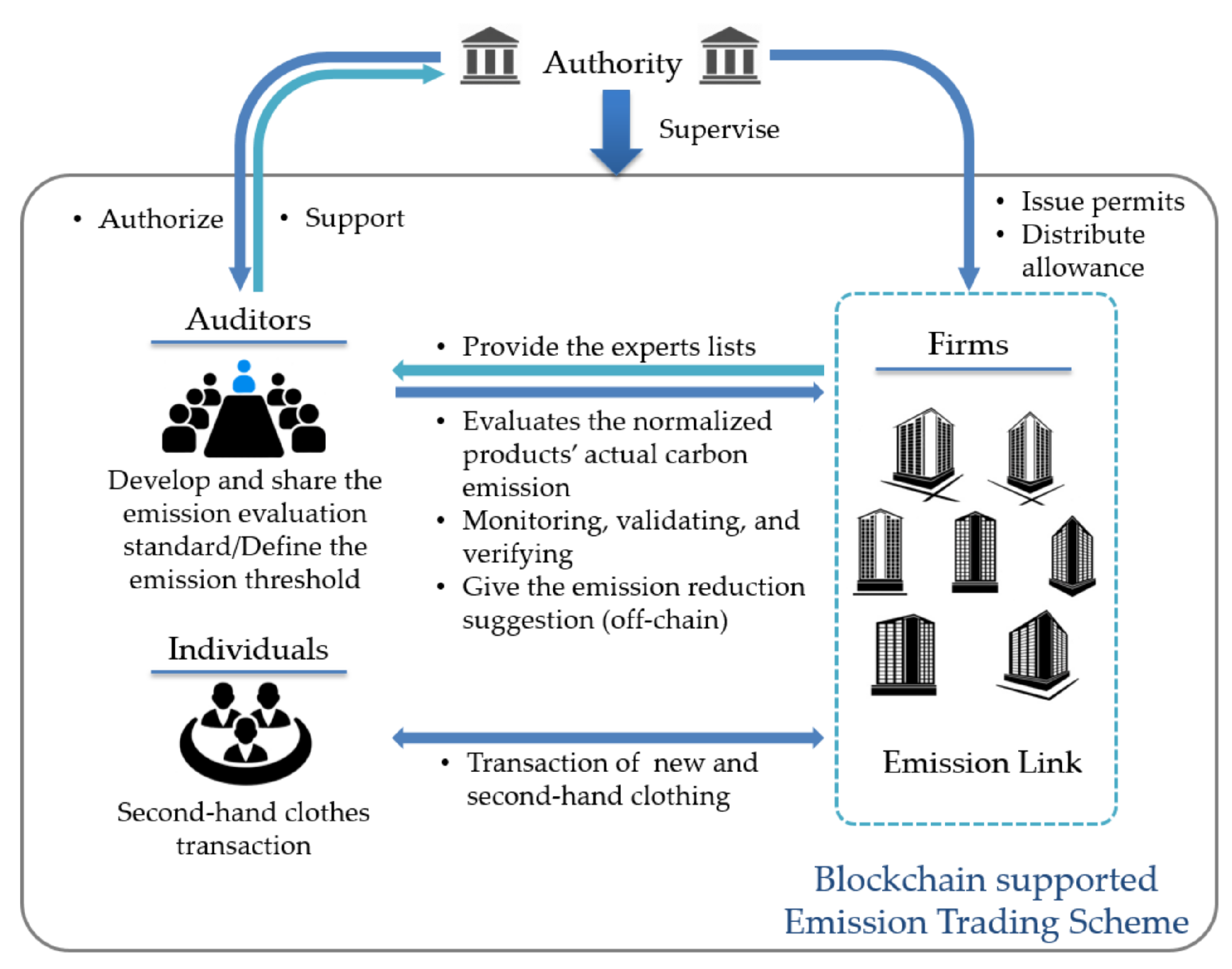
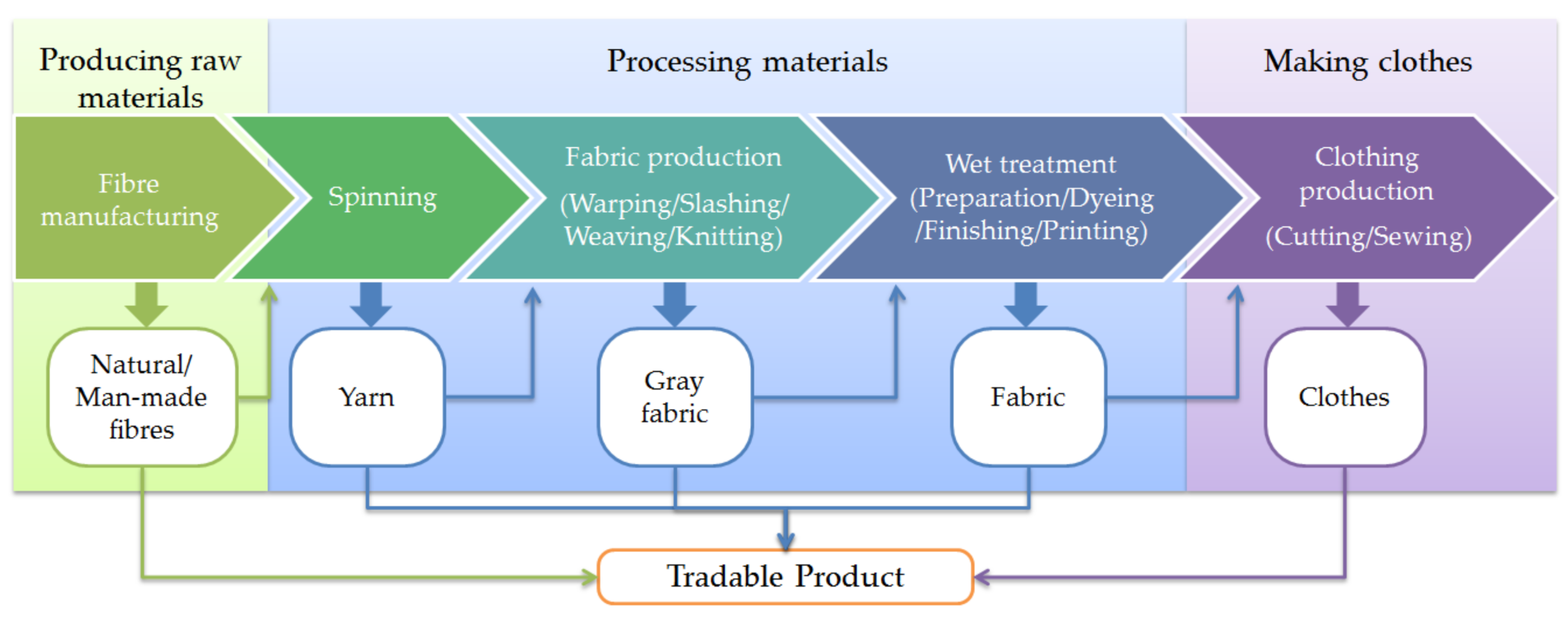
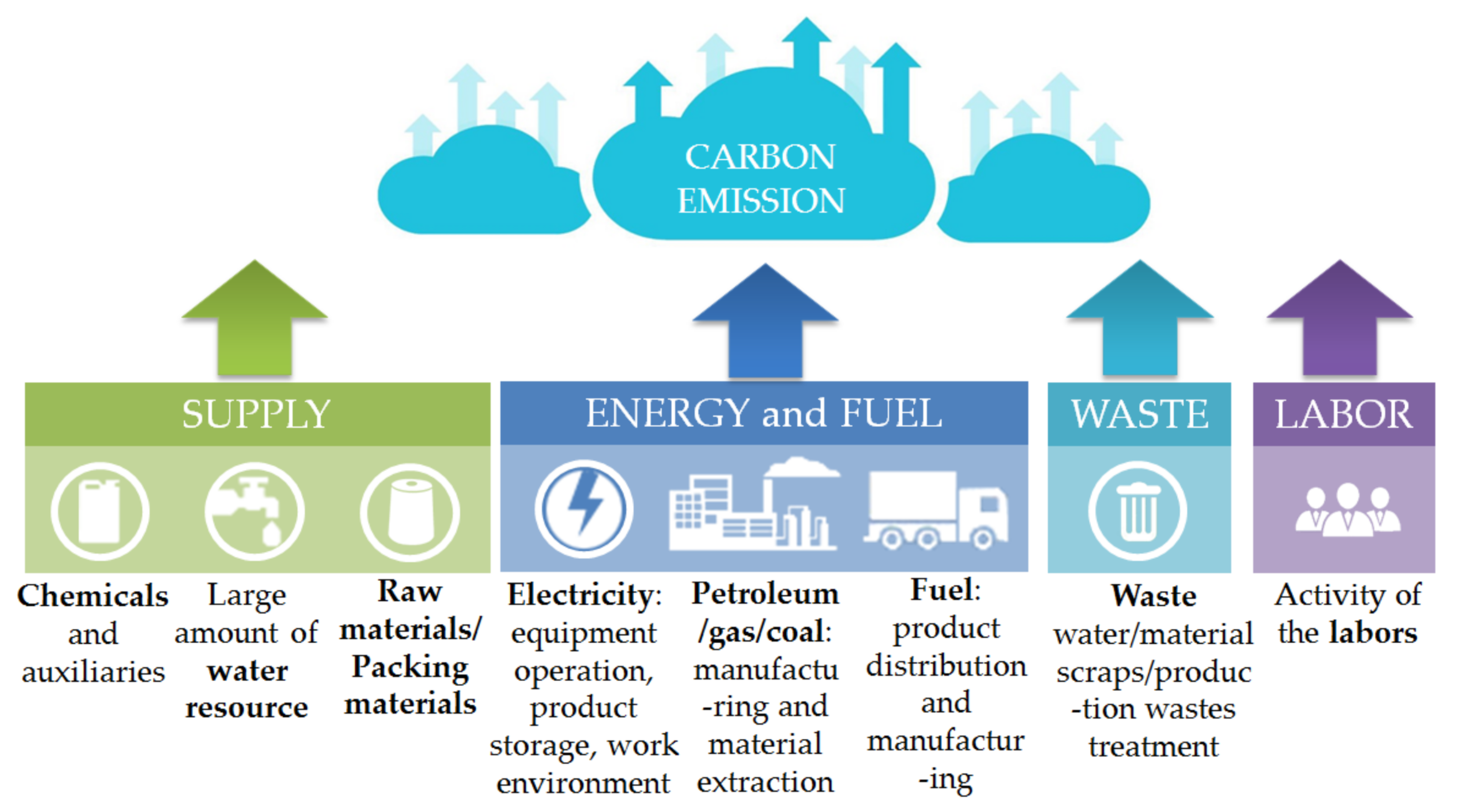
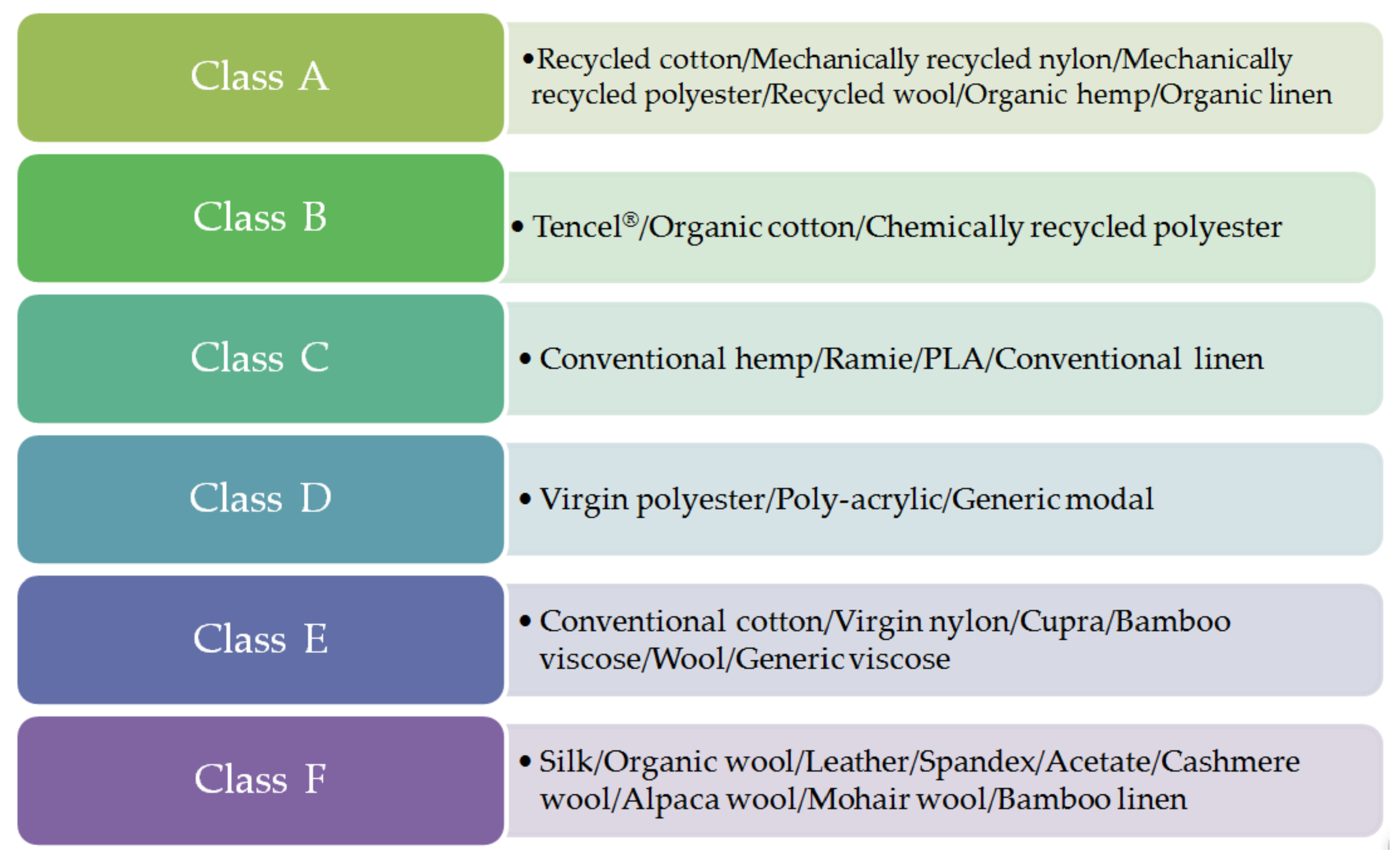

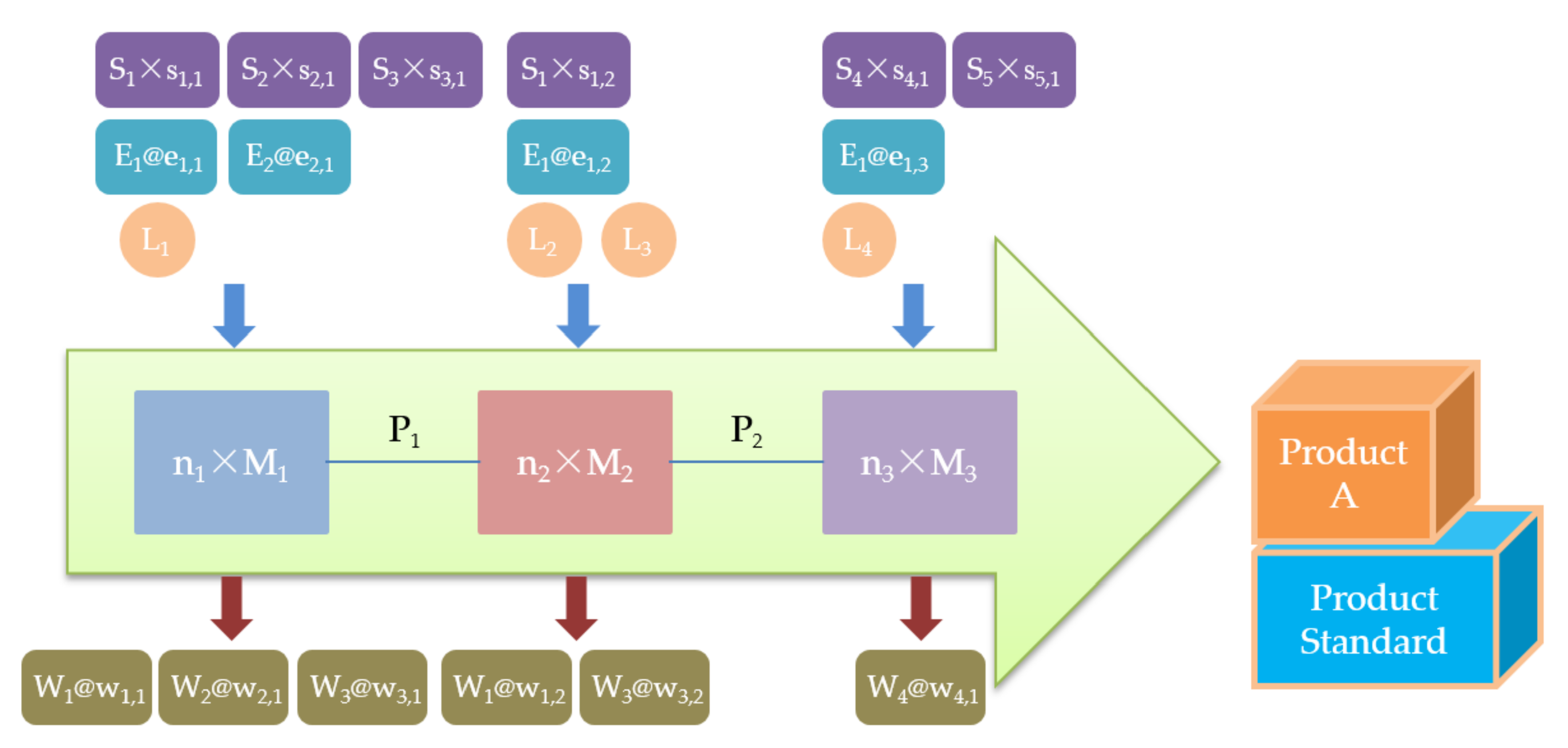
| Role | Holder | Capacity | Responsibility | ||
|---|---|---|---|---|---|
| Issuance | Transaction | ||||
| Authority | Ministry of textile industry or the equivalent government body | Issues the permits (allowance units) | Distribute carbon allowance units | 1. Create, explain and enforce the ETS policy | |
| 2. Facilitate the implementation of the blockchain supported carbon ETS | |||||
| Auditors | Government divisions, experienced consulting firms, universities, etc. | On-chain | 1. Carbon emission standards of the products | - | 1. Summarize and organize the data from the blockchain |
| 2. Carbon emission threshold of the Emission Link | 2. Monitoring, validating, and verifying | ||||
| Off-chain | 1. Reports to the authority | - | 1. Analysis and report industry/firms/products actual carbon emission | ||
| 2. Reports to the firms | 2. Provide customized carbon emission reduction strategies | ||||
| Firms | Business institutions in textile industry | - | Send or receive carbon allowance units as seller or buyer | 1. Report emissions | |
| 2. Comply with the blockchain 3. supported ETS rules including the Emission Link | |||||
| Individuals | Customers | - | Send or receive carbon allowance units mainly as seller | 1. Recycling the used clothing to firms or individuals | |
| Assessment | Grade |
|---|---|
| Null | 0.0–0.5 |
| Slightly more than null, less than very bad | 0.5–1.5 |
| Very bad | 1.5–2.5 |
| Bad | 2.5–3.5 |
| More than bad less than moderate | 3.5–4.5 |
| Moderate | 4.5–5.5 |
| More than moderate less than good | 5.5–6.5 |
| Good | 6.5–7.5 |
| More than good less than very good | 7.5–8.5 |
| Very good | 8.5–9.5 |
| Excellent | 9.5–10.0 |
| Criteria | Weight Coefficient [72] | Conventional ETS | BCRB [9] | Conventional ETS in FAMI | BCELF | |||
|---|---|---|---|---|---|---|---|---|
| Ave. | Min. | Max. | Ave. | |||||
| 1. Environmental performance | 0.168 | 1.18 | 1.37 | 0.84 | 1.38 | 1.53 | 1.45 | |
| 1.1. Direct contribution to GHG emission reduction | 0.833 | 7 | 8.15 | 5 | 8.2 | 9.1 | 8.65 | |
| 1.2. Indirect environmental effects | 0.167 | 7 | 8.15 | 5 | 8.2 | 9.1 | 8.65 | |
| 2. Political acceptability | 0.738 | 4.86 | 5.15 | 4.92 | 5.45 | 5.75 | 5.60 | |
| 2.1. Static (cost) efficiency | 0.474 | 7 | 6.90 | 7 | 7.2 | 7.5 | 7.35 | |
| 2.2. Dynamic (cost) efficiency | 0.183 | 6 | 8.75 | 6 | 8.6 | 9 | 8.80 | |
| 2.3. Competitiveness | 0.085 | 5 | 4.25 | 6 | 4.5 | 5 | 4.75 | |
| 2.4. Equity | 0.175 | 7 | 6.25 | 7 | 8 | 8.5 | 8.25 | |
| 2.5. Flexibility | 0.051 | 7 | 6.85 | 7 | 6.8 | 7.2 | 7.00 | |
| 2.6. Stringency for non-compliance | 0.032 | 5 | 9.25 | 5 | 8.5 | 9.5 | 9.00 | |
| 3. Feasibility of implementation | 0.094 | 0.66 | 0.65 | 0.66 | 0.60 | 0.65 | 0.63 | |
| 3.1. Implementation network capacity | 0.309 | 7 | 6.95 | 7 | 6.7 | 7 | 6.85 | |
| 3.2. Administrative feasibility | 0.581 | 7 | 7.00 | 7 | 6.2 | 6.8 | 6.50 | |
| 3.3. Financial feasibility | 0.110 | 7 | 6.85 | 7 | 6.8 | 7.3 | 7.05 | |
| Weighted total | 6.69 | 7.17 | 6.42 | 7.43 | 7.92 | 7.68 | ||
© 2018 by the authors. Licensee MDPI, Basel, Switzerland. This article is an open access article distributed under the terms and conditions of the Creative Commons Attribution (CC BY) license (http://creativecommons.org/licenses/by/4.0/).
Share and Cite
Fu, B.; Shu, Z.; Liu, X. Blockchain Enhanced Emission Trading Framework in Fashion Apparel Manufacturing Industry. Sustainability 2018, 10, 1105. https://doi.org/10.3390/su10041105
Fu B, Shu Z, Liu X. Blockchain Enhanced Emission Trading Framework in Fashion Apparel Manufacturing Industry. Sustainability. 2018; 10(4):1105. https://doi.org/10.3390/su10041105
Chicago/Turabian StyleFu, Bailu, Zhan Shu, and Xiaogang Liu. 2018. "Blockchain Enhanced Emission Trading Framework in Fashion Apparel Manufacturing Industry" Sustainability 10, no. 4: 1105. https://doi.org/10.3390/su10041105





